Can this once-in-a-generation event transform education systems?
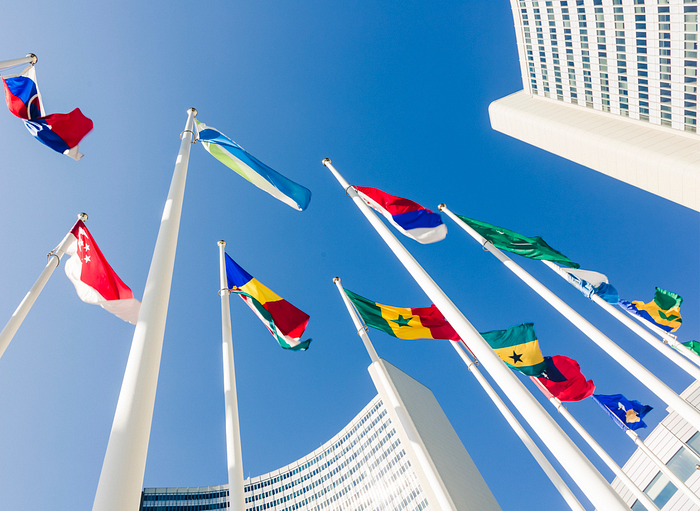
We’re in a global learning crisis that had worsened even before the pandemic.
In 2015, 53 per cent of all children in low- and middle-income countries suffered from learning poverty, unable to understand a simple written text by age 10.
In 2019, global learning poverty rose to 57 per cent.
For 2022, experts project 70 per cent of all 10-year-old children can’t understand a simple written text.

The reasons?
Manifold and often systemic — undertrained, undervalued, and underpaid teachers, access to education, an education financing gap, a lack of early childhood education, and poverty traps perpetuating existing disparities.
And last but not least the relatively recent realization that schooling doesn’t equal learning.
Even though more and more children attend school worldwide, many go there day after day, not understanding anything. Education systems leave a lot of children behind in learning as they progress in schooling.
So, do we really need to solve another crisis?
Yes, because education is the key.
Education and learning underpin almost all individual, social, environmental, and economic goals. If we solve the education and learning crisis, we solve many other prevalent problems, such as climate change, poverty, equity, and mental health.
So how can we solve the learning crisis and create education systems that enable all children to thrive in life?
In 2022, I explored this question from different angles — I interviewed brilliant people for my work with Big Change and Teach For All, among others. I gave a TED talk on learning, visited schools in Estonia, and attended education conferences in Paris, Salzburg, and New York.
This article summarizes what I’ve learned about changing education systems. You first get a framework to think about system change and transformation, followed by three things I took away from the United Nations Transforming Education Summit.
“If you are serious about creating a safe and sustainable future for children then be serious about education.”
— Malala Yousafzai, Education Activist and Nobel Peace Prize Laureate
1) What is Education Transformation?
To set the scene, we need to clarify two things — the difference between transformation and reform (and why it’s no contradiction) and a tool for thinking about systems change.
The difference between education transformation and reform
“A candle does not become a light bulb through many small improvements,” Dr Teresa Torzicky, from the Innovation Foundation for Education, told me during a joint project in 2020.
At that point, I didn’t grasp the complexity of her words.
As a former teacher, I felt improving what and how we teach young people is the most valuable thing to focus on.
I conceptualized and co-authored a publication on what we can learn in and from the pandemic for the foundation for innovation in education.
I co-led the Youth Entrepreneurship Weeks, an Austrian government-funded program we ran in 55 schools with 1800 students to unlock young people’s agency.
I supported the formation of a foundation that supports schools, and teachers, to enable all young people to shape the economy and society.
And while all these initiatives improved education systems, they were, as Andreas Schleicher labels efforts that don’t change systems, just the tip of the iceberg. The much larger part, he says, lies beneath the surface and concerns the interests, beliefs, motivations and fears of those involved.

Education reform, tackling individual problems, such as teacher recruitment, or changing individual inputs, such as updating curricula, laws, and infrastructure, is often necessary and can improve education systems.
But education reform doesn’t turn a candle into a light bulb.
António Guterres, secretary-general of the United Nations, said in New York: “We will not end this crisis by simply doing more of the same, faster or better. Now is the time to transform education systems.”
In contrast to reform, transformation shifts the dominant logic of a system by revisiting its current goals and co-defining a purpose that is fit for time and context. Transformation then redesigns all system parts to coherently contribute to this collectively owned purpose.
So what are those things we need to focus on to create lightbulbs, not just better candles? What is required for education transformation?
“We will not end this crisis by simply doing more of the same, faster or better. Now is the time to transform education systems.”
— António Guterres, Secretary-General of the United Nations
Systems Thinking for Transforming Education
Systems thinking is a set of theories, tools, and mindsets to understand complex and interconnected systems. Applied systems thinking can bridge the gap between reality and our visions.
One widely accepted theory in system thinking for change is the Leverage Points Framework by Donella Meadows. She writes about which points to focus on when aiming for sustainable intervention and action for system-level change.
Meadows describes these power points in increasing order of effectiveness. She starts with the tip of the iceberg, parameters that are easier to implement with weak leverage (infrastructure, metrics, materials). She ends with points that are harder to implement but have stronger leverage (goals, mindsets, beliefs).
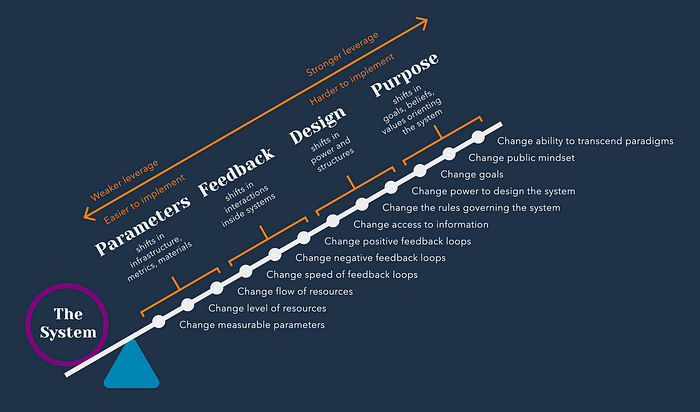
The takeaway?
Systems lead to the results they are designed to achieve. Our systems are not broken but just a result of our systems’ design. The most-effective point for change is the mental models that underpin our system.
Hence, a shared purpose, an alignment on what a system is for, is critical to system-level change that endures over time. It’s impossible to transform education unless you know where you are headed.
Hence, education transformation needs to question the purpose of a system. Such a purpose is anchored in identity, values, beliefs, interests, and fears.
But revealing, redefining, and changing the purpose of a system is easier said than done.
Different studies and research from RISE show leaders often fail to change education systems because they aim to change the visible, lower-leverage elements of a system (resource flows, regulations, metrics) without changing the invisible factors such as the purpose (mindsets, goals, beliefs, and values), and without considering the interrelations of system components.
For example, in a country, Sarah leaves school without foundational skills. To improve outcomes, people from the education ministry ask: “What needs to change in this classroom for Sarah to have foundational skills?”
If textbooks are missing, government officials might decide to provide more textbooks. If teachers are undertrained, they might introduce more teacher training.
Yet, this symptom-only thinking neglects that teachers and students are embedded in a larger system. A lack of system thinking often leads to false conclusions about the cause (something I’ve unknowingly done before).
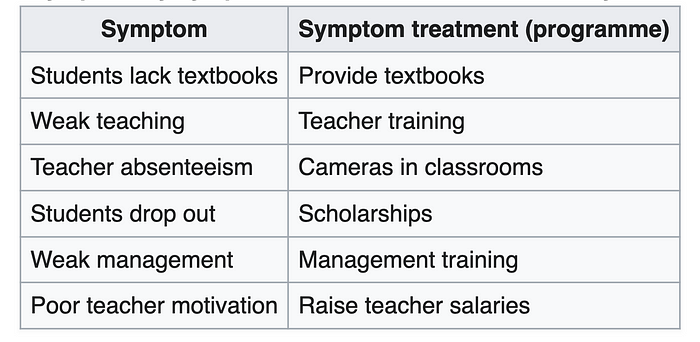
Programmes that fix singular elements might improve some learning outcomes, but without considering the wider system, they are likely doomed to fail.
Education transformation that leads to sustainable system change (not a better candle, but a lightbulb) needs to understand, address, and be coherent with the system’s structures.
So how to work on high-leverage points that can transform education?
“All too often, programmes are designed to address one of these symptoms (e.g.: students drop out, teacher motivation), are implemented faithfully, and yet fail to improve learning outcomes. When a programme fails to have the desired impact, it is tempting to look for a devil in the details, some aspect of programme design or execution that could be tweaked to produce better performance. But often the devil is in the system, not in the details. The programme failed not because of a design flaw, but because of its overall incoherence with the rest of the education system.”
— Marla Spivack, Research on Improving Systems of Education (RISE) Directorate
3 Lessons from the Transforming Education Summit
In September, world leaders, young people, and other civil society members met at the first-time-in-history United Nations General Assembly Transforming Education Summit in New York.
The Summit’s goal? Creating a global movement for education transformation that pushes policymakers to achieve sustainable development goal four (SDG4) — to ensure inclusive and equitable quality education and promote lifelong learning opportunities for all.
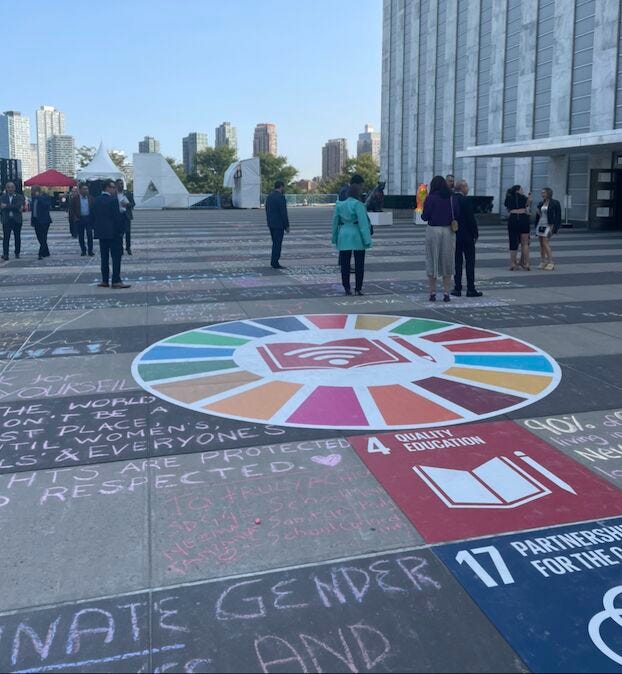
#1 A Collective Commitment and Movement
While we’re not even close to SDG4, there’s a consensus on what’s needed to progress. Education transformation requires a collective commitment and action from leaders at all levels, students, parents, teachers, policymakers and the public at large.
But how do you build a movement, a collaboration between all stakeholders, driven by the public?
In an attempt, the United Nations asked governments to host national consultations to revisit education’s purposes and develop a shared vision, commitment, and alignment of action.
The result was a statement of commitment from each country (full list of all statements here and an interactive map here).
But what’s in these statements that resulted from national consultations?
The centre for global development analysed 106 country submissions and found teaching, learning, and teachers mentioned in almost every statement; Technology (or ICT or digital) was the third most popular term.
Is creating commitments a reason enough for bringing delegations from all over the world to New York (and justifying the climate and human resource cost attached to it)? How do abstract commitments and shared intentions reach the classroom level?
Critics have long been arguing the UN is an inefficient talking shop with insufficient mechanisms to keep countries accountable for their commitments.
Whether these commitments translate to impactful action at the classroom level has yet to be shown, but I can see three benefits through the Summit itself.
First, an international organization prioritises and recognizes localisation and grassroots efforts as mandatory partners in transforming education systems.
Second, the design of the consultations acknowledges intersectionalities. Transforming education requires cross-sectoral involvement, for example, embracing public-private partnerships or learning from evidence-driven system change in health.
Third, the global convening opened the stage for countries already successfully mobilizing and including the broader public in their transformation efforts.
#2 Learning from Countries Walking the Talk
At the Transforming Education Summit, many countries such as Belize, Niger, and Malawi demonstrated transformation efforts, but one country stood out particularly — Sierra Leone.
In Sierra Leone, 80% of the population is under 35. The country faces various challenges — teacher management with significant reliance on non-government paid and unqualified teachers, narrowing persistent gender and geographic disparities, a lack of resources at organizational units, and capacity building at the staff level. And as of 2022, 64 per cent of students in grade four cannot answer a single comprehension question on a basic text.
Yet, Sierra Leone envisions becoming a nation with educated, empowered, healthy citizens capable of realizing their fullest potential by 2035.
How? By making education a top national priority, supported through financial commitment and evidence-informed interventions and innovations.
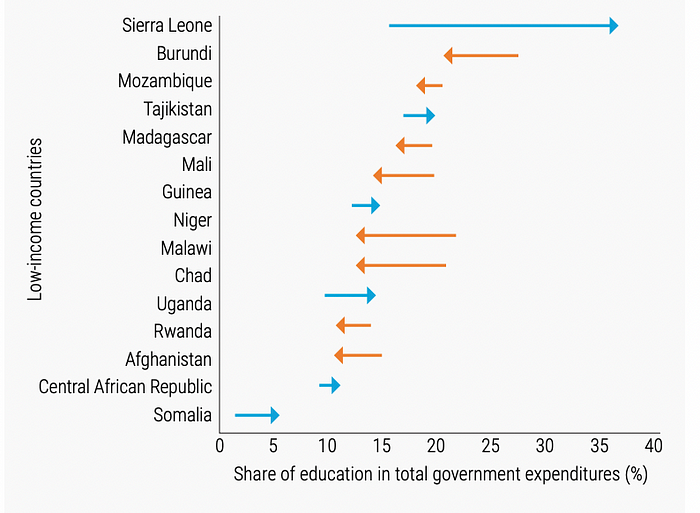
In addition to this top-down commitment to education transformation, Sierra Leone follows a bottom-up approach and includes all members of society.
Sierra Leone was among the only countries to overcome visa and travel barriers and brought students, teachers, partners and civil society members. They all shared key insights from four years of transforming their education system at more than 19 formal events.
David Sengeh, Sierra Leone’s Minister of Education and Chief Innovation Officer, is a role model for unlocking young people’s agency, one of the key drivers for transforming education.
Sengeh shared how lucky he feels to serve the children of Sierra Leone. He even wrote a letter to all pupils in his country.
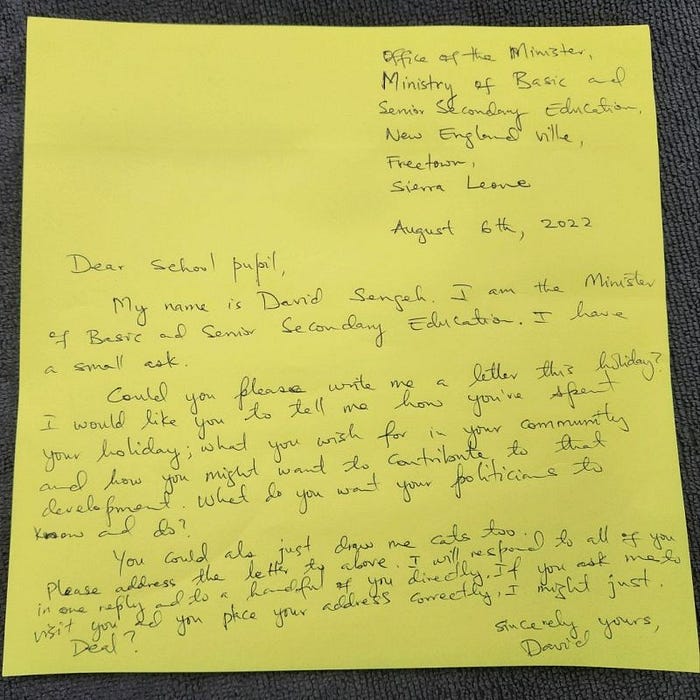
A letter is not enough to transform education systems. But a genuine interest in listening and learning from young people can shift mindsets from resentment to hope, which can translate to action and co-creation.
Sierra Leone also led consultations with every single district and many stakeholders, including parent organizations, teachers’ associations, disabled person organizations, development and donor partners, and government personnel outside of education.
Based on these consultations, Sierra Leone’s President Bio launched the 5-Year Education Sector Plan with clear goals and broad support to improve learning outcomes for all children and youth.
The Centre for Universal Education at Brookings which works with the Sierra Leone Ministry of Education, argued that the government’s vision was well placed given it treats the essential component of foundational literacy and numeracy as a floor, from which to grow from, rather than a ceiling that limits the aspiration for children’s learning
“What do you wish for in your community, and how might you contribute to that development? What do you want your politicians to know and do?”
— David Sengeh, in a letter to all pupils of Sierra Leone
#3 The Need for Intergenerational Partnership
We live in an era of youth-directed age discrimination.
Processes in society and education ensure that people of different ages differ in their access to society’s rewards, power, and privileges. Young people are often seen as minor to older people, their ideas under-supported, and their opinions not included.
For a long time, youth have only tokenistically been included in the policy and decision-making processes. They’ve been used to demonstrate inclusiveness as a “youth voice” without really giving them a seat at the decision-making table.
But as Rebecca Winthrop said at the launch of the Big Education Conversation: “Adults do not need to give young people a voice. They already have one. Adults just need to listen to it.”
More and more power holders recognize that education transformation needs to happen with young people and for young people, and the Summit was stated to be designed around Youth Mobilization.
The United Nations even launched a new instrument, the Youth Declaration, for all stakeholders to shift power to young people and lead us to an age of intergenerational responsibility, co-creation and co-ownership in the process.
More than half a million young people from over 170 countries contributed to the Youth Declaration; through in-person and online, global, regional, national, and grassroots-level dialogues.
The first of its type, the Youth Declaration requests 25 actions by governments for fully accessible and inclusive education systems — centring on the needs of girls and young women, refugees, persons with disabilities, LGBTIQ+ persons, people of colour, indigenous peoples, and other vulnerable and marginalized groups, also emphasizing the intersectionality of these.
And while the declaration is a great sign of the UN’s efforts to include young people in the debate, it’s barely sufficient.
As Restless Development argues, Youth engagement at the Summit was not reflective of young people.
I’m 29 years old. At the Summit, I mainly met young people my age, 25–30. But where were the truly young people? The pupils?
Moreover, young people’s involvement felt gate-kept from the discussions and events attended by current power-holders. The Summit launched seven initiatives, the last being empowering young people to be influential leaders to shape education.
Alex Kent from Restless Development argued that young people don’t need further commitment from older people to be ‘empowered’. Instead, global summits such as the one in New York should acknowledge youth power and then work with young leaders to draw youth power into its core.
Intergenerational collaboration goes beyond youth voice and sees young people as collaborators, or ‘co-agents’, rather than beneficiaries.
Big Change, The Center for Universal Education at Brookings, and the Lego Foundation worked together to launch a tool for intergenerational collaboration — the Big Education Conversation.
The Big Education Conversation, available in seven languages so far, is supporting people and communities worldwide to come together to talk about what education is really for so that it can change for the future.
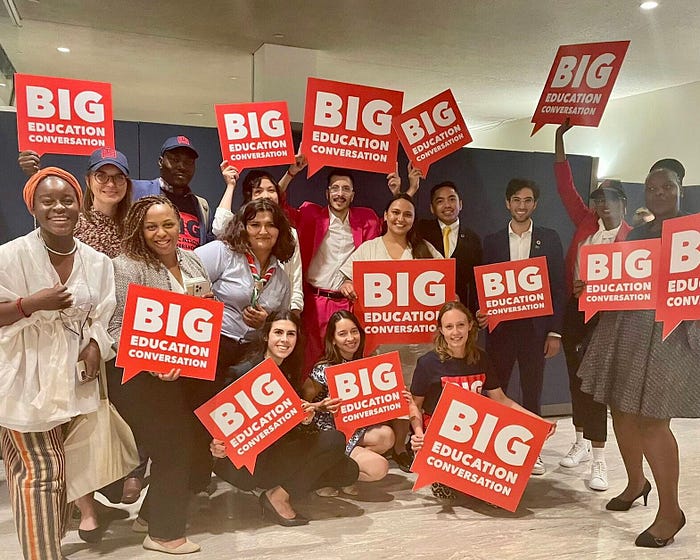
„We need a movement in the world that puts education front and center! That needs mobilization and voices amplified to help governments that are trying and move those that are not.“
— Amina Mohammed, Deputy Secretary General of the United Nations
In Conclusion
If I had to break down everything I learned into four statements, they would be the following.
- Do we need to build back better or new systems? Reform and transformation are no dichotomy. We need both. But we can’t misuse reform to delay transformation. Instead, we must collectively co-define and build upon new purpose(s) for education while improving the existing system.
- Which purpose(s) to focus on? Different purposes of education don’t compete against each other. It’s not post-pandemic recovery or tackling the poor learning outcome, mental health, or girls’ education. Transformation agendas are not a contradiction but can go hand in hand and can cross-amplify progress.
- Who is deciding the why? And which voices are not heard? Young people aged 10 to 29 need to co-lead the change. Their ideas must be included through intergenerational partnerships and alliances, supported by organizations that know how to involve young people meaningfully.
- What’s the education equivalent to getting to net zero? We need a global metric for education transformation to hold countries and decision-makers accountable and learn along the way. A metric should be rooted in learning outcomes, as well as the health and well-being of all people involved.
“This is a once-in-a-generation opportunity for us to radically transform education,” U.N. Deputy Secretary-General Amina Mohammed told reporters ahead of the education summit at U.N. headquarters in New York. “We owe it to the coming generation if we don’t want to witness the emergence of a generation of misfits.”
With the Transforming Education Summit over, real work starts to happen. Whether the Summit will lead to global action to recover learning losses and transform education systems has yet to be shown. But we owe it to all young people on this planet.
Do you want to read more from me on learning and education?
Subscribe free to my weekly Learn Letter, where I’ll share reflections, tools, and resources that can elevate your love for education and learning.
More Resources
- The Education Changemaker’s Guidebook to Systems Thinking and RISE’s Edsyclopedia
- The World Bank Education Statistics, The World Development Report 2018 on Education, and the Global Education Monitoring Report
- How Education Can Unlock Big Change
- Transforming Education Summit Knowledge Hub, the Youth Declaration, and UNESCO’s report on Futures of Education
- Big Change’s A New Education Story, and Brooking’s Transforming Education Systems: Why, What, and How